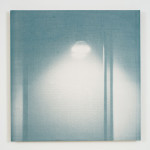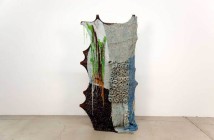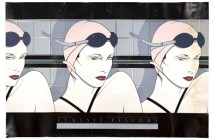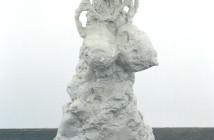R.H. QUAYTMAN: CHAPTER 12 : IAMB AT MIGUEL ABREU GALLERY
The sly objects in R. H. Quaytman’s demanding show at Miguel Abreu Gallery (Op art images screen-printed on plywood, with few exceptions) provoke retinal and philosophic feedback. The work distorts both the focus of an eye and the identity of the I activating the look, thus straining self-perception in the wake of visual perception.
Quaytman pays particular attention to images of lamps, the structures of moiré patterning, and to Hermann grid effects. There are images of rippling patterns. Some of the images are surfaced with shimmering diamond dust. With this said, the effect generated by flitting eye movement (the same optical phenomena exploited in Op art) is complicated by her literary tendencies. The show is titled “Chapter 12: iamb”; and indeed, her past shows are in chapter form. Her use of the term ‘iamb’ is particularly arresting. I will have more to say on the word in a moment.
The show’s stated focus, evidenced by the language in the exhibition’s literature, concerns the conception of a “blind spot” in relation to a lamp. To take this proposition at face value, the work proposes: look into a lamp; see nothing. That is to say, the use value of a lamp is nil in direct observation of its apparatus. There are fascinating permeations in this metaphor when applied to the work and our relation to it; notably, the metaphor illustrates that we experience ourselves peripherally.
The monotone, screened images seem often to originate in newspaper clipping, and they convey the ambiance of a bygone-era: the chosen depictions are rooted in alchemic photography, rather than digital processing; instead of pixels, the prints stress Ben-day dots; the light bulbs pictured are not the spiral-type integrated compact fluorescent lamps of the Al Gore-era. This suggests a challenge to date the work outside of the now. Venture to propose an early-70’s vintage, and the work shifts dimensions. By placing the work within the conceptual climate of the ‘70s, we can consider its historiology. Considering this present work in the light of the presentmanifestation of the world of art - handed down to us in the form of instructions, indexes, and photographic records - dovetails with a predilection to curate swaths of history (which we’ll suppose for the moment as the gut of Quaytman’s art). This suggests an imaginary edge between archive and ephemera - or the tension between living and remembering. If we add to this Quaytman’s biological relationship to post-war art through her father, the geometric and minimalist painter Harvey Quaytman, the reverberating effects of identity-distortion begin to play the dizzying game suggested visually in Op art. Our past is a trick of the I.
As noted, Quaytman’s work encourages a line of thought wherein a piqued eye is philosophically located in the context of an active, contradictory, living I. Here we can simply define I as the agency of the observer. There’s much to be gained in this -in this slippage of meaning between eye and I - such as the beautiful economy in Quaytman’s work. We need look no further than the elastic wording of the show’s title to illustrate this. One can playfully read the term “iamb” as a dyslectic spelling of lamp; one could also hold “iamb” to its literal definition: the two syllable poetic meter, with a stress on the second sound. It is, however, the poetic, homophonous pun on “I am” that provides the self-aware, Cartesian poem in miniature, key to this show. “Chapter 12: iamb,” gives evidence of the dizzying dyslexia involved in seeing oneself being. We are the viewer and the blind spot.
- R.H. Quaytman, Chapter 12: iamb (Fresnell lens), Diamond dust, silkscreen, gesso on wood, 2008.
- R.H. Quaytman, Chapter 12: iamb, silkscreen, gesso on wood, 2008.
- R.H. Quaytman, Chapter 12: iamb, silkscreen, gesso on wood, 2008.
"R. H. Quaytman: Chapter 12: iamb" is on view through February 2, 2008 at Miguel Abreu Gallery.
All images are courtesy of the artist and Miguel Abreu Gallery.







